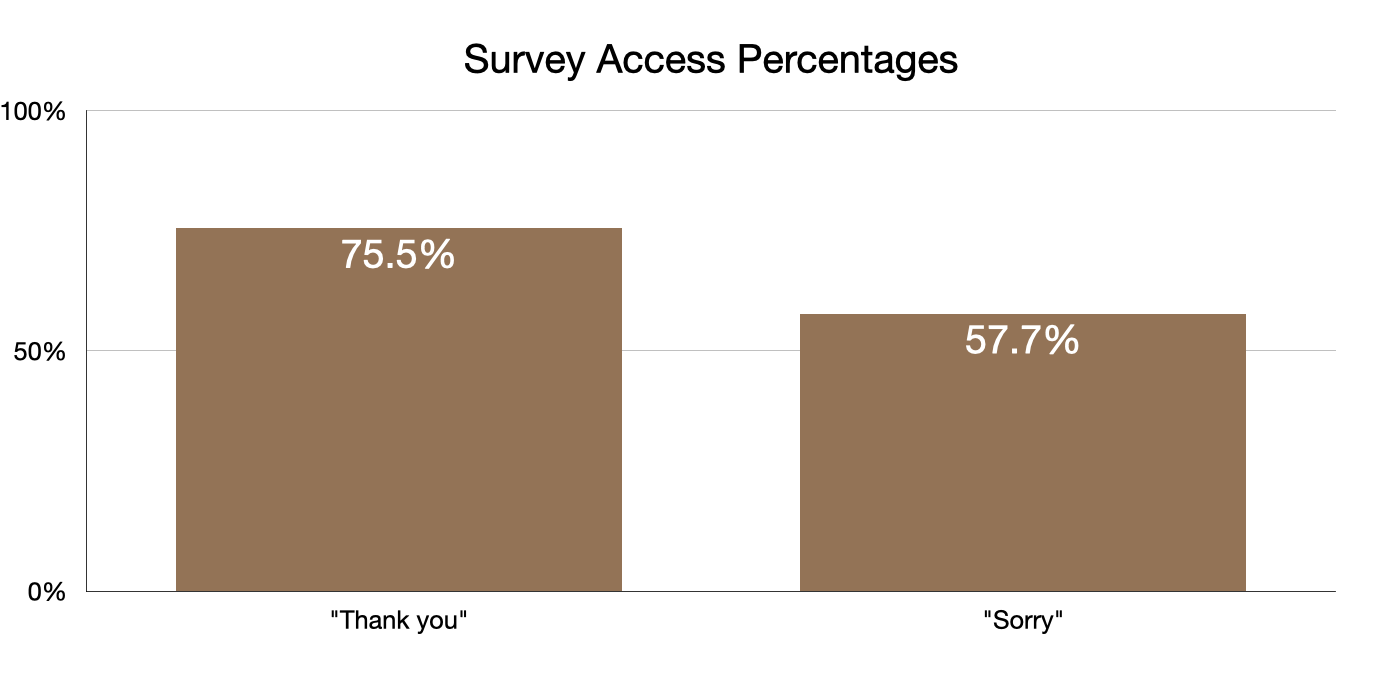It's a busy day and your next customer has been waiting for awhile.
What should you say to acknowledge the delay?
"I'm sorry for the wait."
"Thank you for waiting."
Nothing.
Most of us know saying nothing isn't a great move, but what about the first two options? A series of experiments has revealed that thanking your customer is the best approach.
The experiments showed that saying "thank you" instead of "I'm sorry" when a customer experiences a delay or another minor service failure can increase customer satisfaction and improve survey participation rates.
The first study was published in 2018 by Yanfen You. The second study was published in 2020 by Yanfen You, Xiaojing Yang, Lili Wang, and Xiaoyan Deng.
Here is a summary of the most interesting results.
Why do we apologize to customers?
Small issues, such as a delay, can damage a customer’s self-esteem. It makes people feel disrespected or less valued. An apology can help restore a customer’s self-esteem and make them feel better again.
This short video illustrates what emotional needs look like in a customer service encounter.
How thanking customers after a delay is more effective
Research shows that thanking a customer after a delay or another small service failure is even more effective at boosting the customer's self-esteem than apologizing.
Here's a quote from Yanfen You, who was involved with both studies.
"Specifically, while an apology strategy restores consumers’ self-esteem (bring it back to the pre-service delay level) through admitting fault and establishing fairness, an appreciation strategy increases consumers’ self-esteem by honoring them as a benefactor and highlighting their merits and contributions."
Four of the experiments in these studies were particularly revealing. Here are the highlights of each one.
Study 1: Restaurant wait time
In this experiment, a restaurant server set the expectation that food would be delivered quickly after guests placed their orders. In reality, it took between 30 and 50 minutes for the guests' food to arrive.
The server did one of three things after delivering the guests' meals:
Thanked the customers for waiting
Apologized for the delay
Did not acknowledge the delay
Afterwards, the server placed a survey card on the table and asked the guests to complete it. Far more guests completed the survey when they were thanked.
Study 2: Delayed compensation
University students were promised compensation for participating in a study. The payment was promised by 8pm that evening, but wasn't deposited until 8pm the following day.
Students received a message that either thanked the students for waiting or apologized for the delay. The participants were then sent a survey link to ask for their feedback about the compensation.
Just like in the first study, more students who were thanked (91.1%) completed the survey than students who received an apology (78.4%). Average satisfaction was also higher for students who were thanked.
Study 3: Inferior gift
In this study, university students were asked to choose between two small gifts for participating in an unrelated laboratory study. Afterwards, they were approached by a lab assistant and asked to complete a short survey about their satisfaction with the lab.
The survey instructions reminded students about the small gift, and mentioned that the actual gift would not be as nice as the one shown to them at the beginning of the study. Some students were thanked for their understanding, others received an apology, and another group didn't receive either a thank you or an apology.
Here are the lab satisfaction ratings for the three groups:
Study 4: Wrong survey
University students were approached by a research assistant and asked to complete a short survey about self-perception in exchange for a candy bar. Students who agreed to participate were handed a tablet with an electronic link to the survey.
When the students handed the tablet back to the assistant after completing the survey, the assistant pretended to realize she had accidentally loaded the wrong survey. She handed the students a card with a QR code printed on it, and explained the QR code would link to the correct survey.
One group of students was thanked for their participation in the study, while another group received an apology for the broken link. More students who were thanked used the QR code to access the survey later on:
Conclusion
Thanking a customer is a more effective than an apology when addressing a customer's emotional needs after a minor service failure such as a delay.
The studies also examined some theoretical situations that suggest combining an apology and a thank you might be even more effective, though this wasn't tested with real service failures. Anecdotally, I’ve often found this technique works well.






